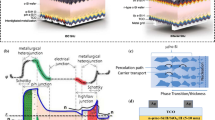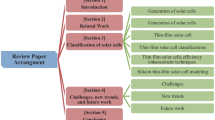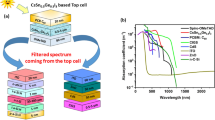Abstract
The effects of single-layer antireflection coatings (SLARCs) on the performance of crystalline silicon (c-Si)-based solar cells have been analyzed numerically. In this study, amorphous (a-WO3) and crystalline (c-WO3) tungsten trioxide was introduced as a SLARC to investigate the performance of photovoltaic cells. Different antireflection coating (ARC) materials including aluminum trioxide (Al2O3), magnesium fluoride (MgF2), titanium dioxide (TiO2), magnesium oxide (MgO), silicon carbide (SiC), silicon dioxide (SiO2), aluminum-doped zinc oxide (AZO), strontium fluoride (SrF2), and titanium nitride (TiN) were used for simulative comparative analysis with WO3 in the search for the highest efficiency of c-Si solar cells. The PC1D simulator was employed to investigate the impact of these ARC materials on device performance. When compared to other ARC materials, the highest efficiency (η) of 19.35% was achieved for a-WO3 thin film with a thickness of 70.7 nm. The a-WO3 ARC layer yielded an open-circuit voltage (Voc) of 0.6363 V, short-circuit current density (Jsc) of 36.86 mA/cm2, and short-circuit current (Isc) of 3.686 A. The Jsc values obtained are in close agreement with the ARC layers' reflectance values. It is important to recognize that the main factors established in this simulation study about SLARC production will make experimental data cheaper and faster.









Similar content being viewed by others
References
M.H. Ahmadi, M. Ghazvini, M. Alhuyi Nazari, M.A. Ahmadi, F. Pourfayaz, G. Lorenzini, and T. Ming, Renewable energy harvesting with the application of nanotechnology: a review. Int. J. Eng. Res. 43, 1387 (2019).
D. Ürge-Vorsatz, L.F. Cabeza, S. Serrano, C. Barreneche, and K. Petrichenko, Heating and cooling energy trends and drivers in buildings. Renew. Sustain. Energy Rev. 41, 85 (2015).
S. Sista, Z. Hong, L.-M. Chen, and Y. Yang, tandem polymer photovoltaic cells—current status, challenges and future outlook. Energy Environ. Sci. 4, 1606 (2011).
I.S. Jung, J. Choi, D.K. Shah, and M.S. Akhtar, Development and characterization of solar simulator for solar cells. J. Nanoelectron. Optoelectron. 15, 720 (2020).
D.K. Shah, Y.-H. Son, H.-R. Lee, M.S. Akhtar, C.Y. Kim, and O.-B. Yang, A stable gel electrolyte based on poly butyl acrylate (PBA)-co-poly acrylonitrile (PAN) for solid-state dye-sensitized solar cells. Chem. Phys. Lett. 754, 137756 (2020).
L.C. Andreani, A. Bozzola, P. Kowalczewski, M. Liscidini, and L. Redorici, Silicon solar cells: toward the efficiency limits. Adv. Phys. X 4, 1548305 (2019).
T. Tiedje, E. Yablonovitch, G.D. Cody, and B.G. Brooks, Limiting efficiency of silicon solar cells. IEEE Trans. Electron Devices 31, 711 (1984).
M.A. Green, Limits on the open-circuit voltage and efficiency of silicon solar cells imposed by intrinsic auger processes. IEEE Trans. Electron Devices 31, 671 (1984).
T. Saga, Advances in crystalline silicon solar cell technology for industrial mass production. NPG Asia Mater. 2, 96 (2010).
A. Tavkhelidze, A. Bibilashvili, L. Jangidze, and N.E. Gorji, Fermi-level tuning of G-doped layers. Nano 11, 505 (2021).
D.D. Smith, P. Cousins, S. Westerberg, R. De Jesus-Tabajonda, G. Aniero, and Y.-C. Shen, Toward the practical limits of silicon solar cells. IEEE. J. Photovolt. 4, 1465 (2014).
R. Sharma, G. Amit, and V. Ajit, Effect of single and double layer antireflection coating to enhance photovoltaic efficiency of silicon solar. J. Nano-Electron. Phys. 9, 2 (2017).
L. Dobrzański, M. Szindler, A. Drygała, and M. Szindler, Silicon solar cells with Al2O3 antireflection coating. Open Phys. 12, 666 (2014).
D. Hocine, M. Belkaid, M. Pasquinelli, L. Escoubas, J. Simon, G. Rivière, and A. Moussi, Improved efficiency of multicrystalline silicon solar cells by TiO2 antireflection coatings derived by APCVD process. Mater. Sci. Semicond. Process. 16, 113 (2013).
B. Dhamodharan and D.S. Periyasamy, Analysis of solar cell with MGO anti-reflective coating. Int. J. Sci. Res. Dev. 4, 415 (2016).
A. Sultanov, K. Nussupov, and N. Beisenkhanov, Investigation of SiC based antireflection coatings for Si solar cells by numerical FTDT simulations. Mater. Today Proc. 49, 2511 (2022).
K. Sobahan, Y.J. Park, J.J. Kim, and C.K. Hwangbo, Nanostructured porous SiO2 films for antireflection coatings. Opt. Commun. 284, 873 (2011).
P.A. Ilenikhena, Fabrication and optical characterization of improved electroless chemically deposited strontium fluoride (SrF2) thin films at 320 K. J. Niger. Assoc. Math. Phys. 11, 415 (2007).
N. Venugopal, V.S. Gerasimov, A.E. Ershov, S.V. Karpov, and S.P. Polyutov, Titanium nitride as light trapping plasmonic material in silicon solar cell. Opt. Mater. 72, 397 (2017).
N.M. Saeed and A.M. Suhail, Enhancement the optical properties of zinc sulfide thin films for solar cell applications. Iraqi J. Sci. 53, 88 (2012).
F. Haque, K.S. Rahman, M.A. Islam, Y. Yusoff, N.A. Khan, A.A. Nasser, and N. Amin, Effects of growth temperatures on the structural and optoelectronic properties of sputtered zinc sulfide thin films for solar cell applications. Optical. Quan. Electr. 51, 1 (2019).
M. Chinnasamy, R. Rathanasamy, S. Sivaraj, G.V. Kaliyannan, M.S. Anbupalani, and S.K. Jaganathan, Influence of ZnSe surface coatings for enhancing the performance of multicrystalline silicon solar cells. J. Electron. Mater. 51, 2833 (2022).
R.R. Phillips, V. Haynes, D.A. Naylor, and P. Ade, Simple method for antireflection coating ZnSe in the 20 μm wavelength range. Appl. Opt. 47, 870 (2008).
M.A. Jabbar and T.J. Alwan, Design of anti-reflection coatings for application in the infrared region (10.6 micron). Iraqi J. Sci. (2020). https://doi.org/10.24996/ijs.2020.61.11.13.
M.A. Eghfeli, S.A. Hadi, N.E. Atab, and A. Nayfeh, Presented at the 2016 IEEE 43rd photovoltaic specialists conference (2016), p. 2765.
Y. Lu, X. Zhang, J. Huang, J. Li, T. Wei, P. Lan, Y. Yang, H. Xu, and W. Song, Investigation on antireflection coatings for Al: ZnO in silicon thin-film solar cells. Opt. Int. J. Light Electron Opt. 124, 3392 (2013).
J.R. Sharma, G. Das, A.B. Roy, S. Bose, and S. Mukhopadhyay, Design analysis of heterojunction solar cells with aligned AZO nanorods embedded in p-type Si wafer. Silicon 12, 305 (2020).
R. Tällberg, B.P. Jelle, R. Loonen, T. Gao, and M. Hamdy, Comparison of the energy saving potential of adaptive and controllable smart windows: a state-of-the-art review and simulation studies of thermochromic, photochromic and electrochromic technologies. Sol. Energy Mater. Sol. Cells 200, 109828 (2019).
S. Green, J. Backholm, P. Georén, C.-G. Granqvist, and G. Niklasson, Electrochromism in nickel oxide and tungsten oxide thin films: ion intercalation from different electrolytes. Sol. Energy Mater. Sol. Cells 93, 2050 (2009).
R.J. Mortimer, Electrochromic materials. Annu. Rev. Mater. Res. 41, 241 (2011).
C.G. Granqvist, Electrochromics for smart windows: oxide-based thin films and devices. Thin Solid Films 564, 1 (2014).
M. Lahav and M.E. van der Boom, Polypyridyl metallo-organic assemblies for electrochromic applications. Adv. Mater. 30, 1706641 (2018).
W. Wu, M. Wang, J. Ma, Y. Cao, and Y. Deng, Electrochromic metal oxides: recent progress and prospect. Adv. Electron. Mater. 4, 1800185 (2018).
K. Sadeghi, J.-Y. Yoon, and J. Seo, Chromogenic polymers and their packaging applications: a review. Polym. Rev. 60, 442 (2020).
G.-F. Cai, J.-P. Tu, J. Zhang, Y.-J. Mai, Y. Lu, C.-D. Gu, and X.-L. Wang, An efficient route to a porous NiO/reduced graphene oxide hybrid film with highly improved electrochromic properties. Nanoscale 4, 5724 (2012).
G. Cai, J. Tu, D. Zhou, L. Li, J. Zhang, X. Wang, and C. Gu, Constructed TiO2/NiO core/shell nanorod array for efficient electrochromic application. J. Phys. Chem. C 118, 6690 (2014).
J.-H. Zhang, G.-F. Cai, D. Zhou, H. Tang, X.-L. Wang, C.-D. Gu, and J.-P. Tu, Co-doped NiO nanoflake array films with enhanced electrochromic properties. J. Mater. Chem. C 2, 7013 (2014).
J. Kim, G.K. Ong, Y. Wang, G. LeBlanc, T.E. Williams, T.M. Mattox, B.A. Helms, and D.J. Milliron, Nanocomposite architecture for rapid, spectrally-selective electrochromic modulation of solar transmittance. Nano Lett. 15, 5574 (2015).
D. Zhou, F. Shi, D. Xie, D. Wang, X. Xia, X. Wang, C. Gu, and J. Tu, Bi-functional Mo-doped WO3 nanowire array electrochromism-plus electrochemical energy storage. J. Colloid Interface Sci. 465, 112 (2016).
D. Wei, M.R. Scherer, C. Bower, P. Andrew, T. Ryhänen, and U. Steiner, A nanostructured electrochromic supercapacitor. Nano Lett. 12, 1857 (2012).
A. Llordés, G. Garcia, J. Gazquez, and D.J. Milliron, Tunable near-infrared and visible-light transmittance in nanocrystal-in-glass composites. Nature 500, 323 (2013).
S. Cong, Y. Tian, Q. Li, Z. Zhao, and F. Geng, Single-crystalline tungsten oxide quantum dots for fast pseudocapacitor and electrochromic applications. Adv. Mater. 26, 4260 (2014).
J.-L. Wang, Y.-R. Lu, H.-H. Li, J.-W. Liu, and S.-H. Yu, Large area co-assembly of nanowires for flexible transparent smart windows. J. Am. Chem. Soc. 139, 9921 (2017).
G.A. Niklasson and C.G. Granqvist, Electrochromics for smart windows: thin films of tungsten oxide and nickel oxide, and devices based on these. J. Mater. Chem. 17, 127 (2007).
C.C. Mardare and A.W. Hassel, Review on the versatility of tungsten oxide coatings. Phys. Status. Solidi. (a) 216, 1900047 (2019).
C.M. Lampert and C.-G. Granqvist, Presented at the society of photo-optical instrumentation engineers (SPIE) conference series, (1990).
A. Agrawal, J.P. Cronin, and R. Zhang, Review of solid state electrochromic coatings produced using sol-gel techniques. Sol. Energy Mater. Sol. Cells 31, 9 (1993).
A. Akl, H. Kamal, and K. Abdel-Hady, Characterization of tungsten oxide films of different crystallinity prepared by RF sputtering. Phys. B Condens. Matter. 325, 65 (2003).
E. Özkan and F. Tepehan, Optical and structural characteristics of sol–gel-deposited tungsten oxide and vanadium-doped tungsten oxide films. Sol. Energy Mater. Sol. Cells 68, 265 (2001).
M. Regragui, M. Addou, A. Outzourhit, K.A. El-Idrissi Elb, and A. Bougrine, Sol. Energy Mater. Sol. Cells 77, 341 (2003).
H. Kamal, A. Akl, and K. Abdel-Hady, Influence of proton insertion on the conductivity, structural and optical properties of amorphous and crystalline electrochromic WO3 films. Phys. B Condens. Matter 349, 192 (2004).
M.G. Hutchins, O. Abu-Alkhair, M. El-Nahass, and K. Abdel-Hady, Electrical conduction mechanisms in thermally evaporated tungsten trioxide (WO3) Thin films. J. Phys. Condens. Matter 18, 9987 (2006).
K.H. Tsui, Q. Lin, H. Chou, Q. Zhang, H. Fu, P. Qi, and Z. Fan, Low-cost, flexible, and self-cleaning 3D nanocone anti-reflection films for high-efficiency photovoltaics. Adv. Mater. 26, 2805 (2014).
D. Kc, D.K. Shah, A.M. Alanazi, and M.S. Akhtar, Impact of different antireflection layers on cadmium telluride (CdTe) solar cells: a PC1D simulation study. J. Electron. Mater. 50, 2199 (2021).
B. Hussain, A. Ebong, and I. Ferguson, Zinc oxide as an active n-layer and antireflection coating for silicon based heterojunction solar cell. Sol. Energy Mater. Sol. Cells 139, 95 (2015).
G.S. Thirunavukkarasu, M. Seyedmahmoudian, J. Chandran, A. Stojcevski, M. Subramanian, R. Marnadu, S. Alfaify, and M. Shkir, Optimization of mono-crystalline silicon solar cell devices using PC1D simulation. Energies 14, 4986 (2021).
X. Cai, X. Zhou, Z. Liu, F. Jiang, and Q. Yu, An in-depth analysis of the silicon solar cell key parameters’ optimal magnitudes using PC1D simulations. Optik 164, 105 (2018).
T. Zhang, L. Wang, J. Zhu, J. Liu, and S. Guo, Electron transport and electrical properties in poly (p-Phenylene Vinylene): methanofullerene bulk-heterojunction solar cells. J. Nanoelectron. Optoelectron. 14, 227 (2019).
D. Kc, D.K. Shah, M.S. Akhtar, M. Park, C.Y. Kim, O.-B. Yang, and B. Pant, Numerical investigation of graphene as a back surface field layer on the performance of cadmium telluride solar cell. Molecules 26, 3275 (2021).
M. Basher, M.K. Hossain, and M. Akand, Effect of surface texturization on minority carrier lifetime and photovoltaic performance of monocrystalline silicon solar cell. Optik 176, 93 (2019).
T.M. Clarke and J.R. Durrant, Charge photogeneration in organic solar cells. Chem. Rev. 110, 6736 (2010).
E. Alarousu, A.M. El-Zohry, J. Yin, A.A. Zhumekenov, C. Yang, E. Alhabshi, I. Gereige, A. AlSaggaf, A.V. Malko, and O.M. Bakr, Ultralong radiative states in hybrid perovskite crystals: compositions for submillimeter diffusion lengths. J. Phys. Chem. Lett. 8, 4386 (2017).
G. Hashmi, M.J. Rashid, Z.H. Mahmood, M. Hoq, and M. Rahman, Investigation of the impact of different ARC layers using PC1D simulation: application to crystalline silicon solar cells. J. Theor. Appl. Phys. 12, 327 (2018).
L.R.-D. Marcos, J.I. Larruquert, J.A. Aznárez, M. Fernandez-Perea, R. Soufli, J.A. Méndez, S.L. Baker, and E.M. Gullikson, Optical constants of SrF2 thin films in the 25–780-eV spectral range. J. Appl. Phys. 113, 143501 (2013).
E. Shkondin, T. Repän, O. Takayama, and A. Lavrinenko, High aspect ratio titanium nitride trench structures as plasmonic biosensor. Opt. Mater. Express 7, 4171 (2017).
T. Amotchkina, M. Trubetskov, D. Hahner, and V. Pervak, Characterization of e-beam evaporated Ge, YbF3, ZnS, and LaF3 thin films for laser-oriented coatings. Appl. Opt. 59, A40 (2020).
M.-S. Kim, K.-G. Yim, J.-S. Son, and J.-Y. Leem, Effects of Al concentration on structural and optical properties of Al-doped ZnO thin films. Bull. Korean Chem. Soc. 33, 1235 (2012).
Acknowledgments
This work was supported by the Higher Education Commission (HEC) of Pakistan [Grant No. 8615/Punjab/NRPU/R&D/HEC/2017] to Dr. Khuram Ali.
Author information
Authors and Affiliations
Corresponding author
Ethics declarations
Conflict of interest
The authors declare that they have no conflict of interest.
Additional information
Publisher's Note
Springer Nature remains neutral with regard to jurisdictional claims in published maps and institutional affiliations.
Rights and permissions
About this article
Cite this article
Maqsood, S., Ali, K., Ali, Z. et al. Impact of Amorphous and Crystalline Tungsten Trioxide (WO3) Thin Films as an Antireflection Material for Silicon (c-Si) Solar Cells. J. Electron. Mater. 52, 165–176 (2023). https://doi.org/10.1007/s11664-022-09939-3
Received:
Accepted:
Published:
Issue Date:
DOI: https://doi.org/10.1007/s11664-022-09939-3




